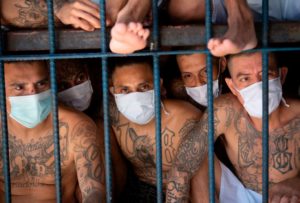“Of all the drug lords I had business relationships with, [El Chapo] was probably the most difficult one,” Margarito Flores tells me. Over years, Flores and his twin, Pedro, distributed 60 tonnes of cocaine, as well as heroin and crystal meth, around America on behalf of Joaquín “El Chapo” Guzmán’s notorious Sinaloa Cartel. But in 2008, the twins turned on the Mexican kingpin, helping to put him behind bars.
Known as J, short for Junior, Flores is 42, but looks younger, with thick cropped hair and wide alert eyes. He’s driven and talkative, disarming with an easy manner and a lively mind that jumps from details of his trafficking logistics to the books he read in prison. He knows both the world of Chicago’s Little Village, where he was born, and small-town Zacatecas, Mexico, where his father hails from. He speaks with a Chicago-Latino accent.
Though he doesn’t have an aggressive demure and was never convicted of violence, Flores was key to networks that have pumped narcotics into America and drowned Mexico in blood. Mexican drug traffickers wouldn’t have made their vast fortunes without US associates to move their product north of the river. “Chapo or Mayo or Arturo couldn’t do what we did in the United States,” Flores says. Indeed, the twins made more bank from their hometown of Chicago than many of the drug lords south of the border.
Flores didn’t exactly choose this world — he was born into it. When his mother was pregnant with him in 1981, his father was incarcerated for being caught with 11 kilos of black tar heroin. He and Pedro grew up with an older brother who became a shot caller for the Latin Kings, a fearsome street gang, as well as a major drug dealer. “I didn’t have your regular childhood,” he tells me. “My brothers were in the most violent, biggest organisation which was the Latin Kings… I am basically being raised in that kind of culture.”
When his father finally came out of prison, he was furious. He was an old-school narco from Zacatecas and forbade the twins from what he saw as the crude, tattooed life of gang bangers. “He despised gang members, believe it or not. It’s this weird contradiction. Because he was in prison with them. He didn’t understand their reasoning.”
His father’s idea of education, meanwhile, was taking the twins down to Mexico to buy marijuana and drive it back to Chicago. On their first trip, aged seven, they helped stash weed in the gas tank. Over the following years, they learned how to find marijuana plantations in the mountains and negotiate with sellers. “My father made sure he introduced us to everyone and that we treated everyone with respect.”
When they were 12, their father went on the run to Mexico. After a stint there, the twins returned to Chicago to live with their Latin King brother — and help him deal drugs. After he too was sent to prison, they began making their own deals with Sinaloa Cartel intermediaries in Chicago. By 17, they had made their first deal — 30 kilos of cocaine — and by 20, they were shifting more than a tonne a month and making millions.
That the twins rose so fast up the ranks was partly thanks to their upbringing, which put them in a special position to link the drug lords in Mexico with the gangs that sold drugs on US streets. They knew both worlds, but weren’t quite part of either. Instead, they styled themselves as businessmen. It helped that they’d had a better education than most of their counterparts: even while trafficking through their teenage years, Margarito had received a high school diploma and Pedro did a couple of semesters of college.
In this business, brains are important. “Drug trafficking is not easy,” Flores says. “Prisons are filled with failed drug traffickers. Cemeteries are filled with failed drug traffickers.” He explains that moving dope in America is about running a smooth logistical operation. The cartel needs the drugs delivered fast and the payment back faster. Traffickers who are slow to move loads and mess up on paying are the ones who get killed. Luckily, the twins were workaholics who took care of every detail as they built a network of independent truck drivers, discreet stash houses, and crucially, money-counting machines.
Meanwhile, the twins kept an eye on the fluctuating cocaine prices in different cities like brokers watching the stock market. Since sale prices are higher the further north you go, they made profits by delivering to the northeast and into Canada. The buying prices are also lower the higher up the chain you get, so the twins cut out the middlemen and built relationships directly with the heads of the Sinaloa Cartel.
Gaining the trust of the top players was not easy, however. In early 2005, an associate of El Chapo kidnapped Pedro and held him for over two weeks, almost starving him to death. Flores went to the mountains, where he successfully negotiated with El Chapo for Pedro’s release — though he ended up paying off a debt that had been caused by El Chapo’s own man messing up. Eventually, the twin’s gained El Chapo’s approval to buy cocaine directly from the inner circle of Sinaloa drug lords at a cheaper rate. This would boost their trafficking to more than three tonnes a month and up to $10 million in profit.
El Mayo (or Ismael Zambada), another Sinaloa Cartel warlord, was easier to work with, praising their ability to move so much powder, and joking about how much they could have moved if they were triplets. “He was a fierce man, but he was also one of the fairest,” recalls Flores. Now 76 years old, El Mayo has never been inside a jail cell. The veteran drug lord boasts a reputation for smoothing relations and paying off cops.
“He reminded me a lot, even nicer probably, than my father,” Flores says. “I feel like he had genuine love and respect for us… When it came to any type of business, he would be like, ‘Whatever you guys decide and you know what, here is an extra something for you guys.’ It doesn’t surprise me that he continues to be the head of the organisation, the most successful one for sure.”
In their case, US prosecutors portrayed El Chapo as the supreme head of the Sinaloa Cartel. But Flores’s account paints a picture of a federation with a cupola of bosses: among these, Arturo Beltrán Leyva, a roughneck known as Barbas, or The Beard, was actually moving more cocaine. “He was a calculator; I would grab my phone to calculate and before I even pressed a number, he was already telling you what it was,” says Flores. “He was one of the best businessmen I feel like there was in drug trafficking.”
However, Beltrán Leyva also had a reputation for murder and even cannibalism. Margarito says it bothered him that he wasn’t as famous as Chapo and Mayo, and he used violence to put himself on the map. “It’s always about legacy… To them, you are your name,” he says. “He had no limit when it came to violence.”
Another gangster with a bloody reputation was El Mencho, or Nemesio Oseguera Cervantes. When Mexican federal agents arrested the twins in Jalisco, Mencho led a squad of gunmen to force their release. He was then a rising figure in a local group affiliated with the Sinaloa mob, but Margarito says he was an aggressive, hungry guy and he didn’t like to do business with him. “He had that chip on his shoulder, a violent man from the beginning.”
In 2008, these Sinaloan bosses broke into a bloody civil war. The violence had various fronts, but a central battle was between Beltrán Leyva and El Chapo — The Beard versus Shorty. As these old childhood friends turned into bitter enemies, their gunmen painted the streets of Sinaloa with blood. In May, sicarios fired 500 bullets into a son of El Chapo, Édgar, at a Culiacán shopping mall, and from then on residents lived with ensuing daily revenge hits.
The twins were ordered to choose between Chapo and Beltrán Leyva. But by this point, they were working with the DEA. They tried to play the two men off against each other, hoping to gather evidence on both. “We were threatened by the two most powerful, most violent, drug cartels I would say in the world at that time,” says Flores.
Flores has a tear in his eye when he describes their decision to co-operate. He realised his path would only lead to death or the Super Max but flipping gave him a glimmer of hope. “I had a spiritual epiphany one day,” he says. “I felt like, I wanted to do something good for my family.” I’m reminded of his earlier description of watching the film Scarface as a kid: “Scarface was a great story, but it never motivated us to die like him.”
With the civil war raging, the twins began recording their dealings with traffickers. The risk of being caught snitching was huge, but they made good under-covers. Their sentencing memorandum has a list of 54 recorded conversations with narcos. Finally, they got El Chapo himself on the phone. To lure him in, Pedro renegotiated the price of a batch of heroin they had already received. “In the drug business you don’t do that,” Flores says. “You don’t receive a shipment and then try and get a better price.”
On 30 November 2008, the twins handed themselves into custody and went from living the life of millionaire narcos to witnesses in jail cells. Their cooperation led to indictments against everybody: Chapo, Mayo, Beltrán Leyva, their sons and brothers and lieutenants, and even members of the twins’ own organisation in Chicago. They spent years alone in prison, segregated for their own safety. Then in 2018, Pedro took the stand and testified against Chapo in his showcase trial in Brooklyn.
As a reward, the twins were given 12 years in prison rather than a life sentence. At least, Flores says, they are alive and able to be fathers and husbands. Since his release, he has been trying to turn his life around. He’s giving classes to law enforcement about the inner workings of cartels with a group called Dynamic Police Training and testified before the Congressional “Task Force to Combat Mexican Drug Cartels,” headed by Rep. Dan Crenshaw. “I have this need to do something with all my knowledge,” he says. “I want to make sure that by the time I leave here my legacy is something positive.” Indeed, Mexican journalists often complain that the US side of the trafficking equation is poorly documented — Flores is shedding much-needed light on it.
“This a cautionary story, we are not trying to promote the life at all,” Flores says. “My brother and I were always applauded for bad, so now it feels good to go to an event where I am teaching law enforcement. Where I get a hug or a handshake or a standing ovation. And they tell me ‘Thank you.’”
A version of this interview appeared on Ioan Grillo’s CrashOut Substack.
Disclaimer
Some of the posts we share are controversial and we do not necessarily agree with them in the whole extend. Sometimes we agree with the content or part of it but we do not agree with the narration or language. Nevertheless we find them somehow interesting, valuable and/or informative or we share them, because we strongly believe in freedom of speech, free press and journalism. We strongly encourage you to have a critical approach to all the content, do your own research and analysis to build your own opinion.
We would be glad to have your feedback.
Source: UnHerd Read the original article here: https://unherd.com/



